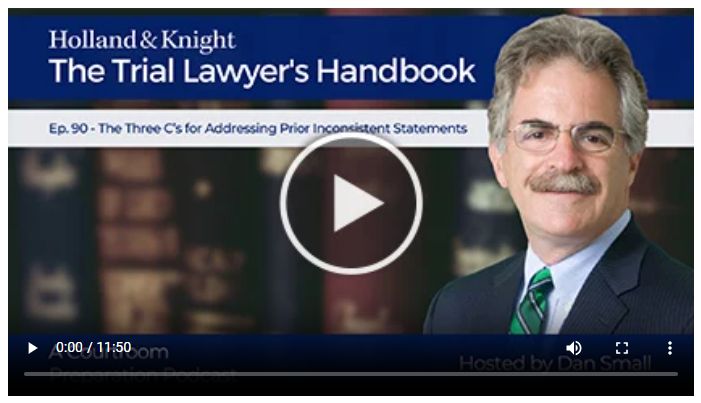In this episode of "The Trial Lawyer's Handbook" podcast series, litigation attorney Dan Small breaks down a powerful cross-examination technique for challenging a witness' credibility that he calls "The Three C's": Commit, Credit and Confront. Using a real example from the Farmers Export grain elevator explosion trial, the episode illustrates how to skillfully expose a witness' prior inconsistent statements to undermine their testimony. By first having the witness commit to their current testimony, then credit their previous statement and finally confront them with the contradiction, Mr. Small was able to successfully dismantle a key defense witness' credibility. This episode offers valuable insights for trial lawyers aiming to master effective witness impeachment strategies.
Listen to more episodes of The Trial Lawyer's Handbook here.
This podcast episode was adapted from Mr. Small's book Lessons Learned from a Life on Trial: Landmark Cases from a Veteran Litigator and What They Can Teach Trial Lawyers.
Podcast Transcript
Dan Small: There are many ways to attack a witness's credibility:
- Opportunity to observe: Was it too far or too dark for the witness to see?
- Bias: Does the witness have a prior history — good or bad — with one of the parties?
- Character: Has the witness been convicted of crimes or other things that would affect his character or her character?
- Contradictory evidence: Are there documents or other evidence that contradict the witness's story?
And lots more.
One of the classic challenges to a witness's credibility is the prior inconsistent statement. Somewhere along the way, the witness has said something — in a statement, deposition, tape, wherever — that contradicts their testimony at trial. One of the keys to a successful cross-examination is knowing how to effectively use that prior inconsistent statement. For that purpose, I learned from great lawyers and great teachers to use the "Three C's": commit, credit and confront.
- Commit the witness to the current statement. Usually the direct examination if it's at trial
- Credit the prior statement, and then
- Confront with the contradiction
In the Farmers Export grain elevator explosion trial that we've talked about in the past several episodes, the defense started off claiming they had done nothing wrong. This was absurd. But as witness after witness talked about how dirty the grain elevator was, with piles of grain dust everywhere, and how management was pushing so hard to dump railcars faster and faster that sparks were flying, they fell back on two other lines of defense:
First: Intent. "OK, well maybe they screwed up, but they're not criminals. They didn't intend to hurt anyone."
And second: motive. "This is really just a dispute between labor and management."
To some extent, that second one is how it appeared. The laborer witnesses talked about how bad things were and how little management cared about safety. The management witnesses talked about how clean it was and how safety was their highest priority. So imagine defense counsel's delight when they found a witness who bridged that gap. We'll call the bridge witnesses Billy. Billy had been a laborer at the time of the explosion, but had since been promoted to management and now supported management's story all the way.
I don't have the transcript or exhibits, so all this is from memory, but my memory is pretty clear. Basically Billy testified on direct that:
- Management was very conscientious.
- Cleaning crews were sweeping the elevator regularly.
- The elevator was so clean, you could eat off the floor.
- Safety was the highest priority.
- They were very careful in the rail dump.
On the night of the explosion, it just happened that OSHA Investigator Don Donnelly happened to be driving in Galveston and heard about the blast on his police scanner radio. He raced to the chaotic scene, and was there with the first responders, and immediately starting to interview witnesses.
That night, Don had in his car a pad of simple one-page interview forms. At the top, after the witness's name, it said something like, "I voluntarily and willingly make this true statement." The middle had space for Don to write up a brief statement. Then at the bottom, above the wit- ness's signature, it said: "I have carefully reviewed the above statement and it is true and accurate. Signed under pains and penalties of perjury." Short and sweet.
On the night of the explosion, Investigator Donnelly had interviewed Billy and had him sign a statement. In the chaos of the long night, Billy had long since forgotten. I had actually considered calling Billy as a government witness, but I was told no that he had gone over to the "Dark Side," so I didn't call him.
When I saw his name on the defense witness list, I searched my soul, and by the way, more than a few law books, about whether I had to turn over his statement. In a criminal case like this, if someone is a defense witness, the government is generally not obligated to turn over that witness's statement unless it's exculpatory — which this certainly was not.
So I thought long and hard, lost some sleep, and didn't turn it over. I kept the statement buried in my file and waited for the cross-examination. Was I nervous? No, I was scared to death, are you kidding? Lawyers can go through their whole career without being handed a setup like this. Yet here I was, two years out of law school, and scared that I would blow this opportunity, and with it, my case. All I could think of as I sat there were those three words: "commit, credit and confront!"
Again, there is no transcript or exhibits exist of the cross-examination, but here's my memory, in a much condensed form:
The first C is commit. I asked Billy to confirm:
Me: You testified for the company today.
Billy: Yes
Me: You are now part of the company's management.
Billy: Yes
Me: You met with the company's counsel before you testified today.
Billy: Yes
Billy confirmed all of the above, so I continued by having him make his statement about the work conditions of the grain elevator and the management style of the company at the time of the explosion. His claims matched those of members of management who testified before him and confirmed his testimony on direct.
- Management was conscientious.
- Safety was their highest priority.
- Cleaning crews swept the grain elevator regularly.
- It was so clean you could eat off the floor. I particularly liked that one.
Now that Billy had committed to his current statement - to his direct examination - it was time for me to credit the prior statement. So I asked him about his memory of the night of the explosion. I asked:
There were rescue workers, firefighters and investigators on site that night?
Billy said yes.
Me: Interviewing witnesses is a key part of any investigation, isn't it?
Billy: Yes.
Me: It's important for witnesses to tell them the truth.
Billy: Yes.
Me: They have to know the truth so they can try and prevent it from happening again.
Billy: Yes.
Me: 18 people died that night.
Billy: Yes.
Me: You wouldn't want that to happen again, would you?
Billy: No, no. I wouldn't.
Me: Did you lie to the investigator that night?
Billy: No! No. Absolutely I didn't.
Me: Would you lie to the investigator?
Billy: No! No.
Me: There was an OSHA investigator there that night who interviewed witnesses. Do you remember that?
Billy: No.
I asked agent Don Donnelly to stand.
Me: Sir do you recognize Mr. Donnelly?
Billy: No. Never seen him before.
Me: Actually, he interviewed you the night of the explosion and wrote down what you said. Do you remember that?
Billy: No, no, never happened.
Me: He asked you to read it carefully and sign it. You don't remember?
Billy: No, no, that's ridiculous
Me: Sir this is Exhibit 35 I'm handing you. Do you recognize your signature? At the bottom of the page?
And there was a long pause. And then very quietly, Billy said:
Yes. Yes I do.
Me: You signed this under oath. Just like the oath you took here, didn't you?
Billy: Yes. Yes I guess I did.
Me: You signed a sworn statement, verifying that the information was true and correct? That's what it says, right?
Billy: Yes.
Me: And you knew how important it was to tell the truth?
Billy: Yes, I guess I did.
Then came the final C, confront. To compare the sworn statement he said at the trial on his direct, to the sworn statement he made the night of the explosion. I linked his direct to the company.
Me: Your statement for the company today was "management was conscientious", right?
Billy: Yes.
Me: But your sworn statement that night, with 18 people dead, was "all management cared about was making their quotas."
Billy: Yes, I guess I said that.
Me: Your statement for the company today was "cleaning crews swept the elevator regularly. The elevator was so clean you could eat off the floor." That's what you said, isn't it?
Billy: Yes that's what I said.
Me: Your statement that night, the night of the explosion, was "crews had been taken off cleaning assignments to dump more railcars. [and] There were piles of grain dust everywhere." That's what you said that night.
Billy: Yes, yes, I guess it is.
Me: Your statement for the company on direct was "Safety was highest priority." You remember that testimony?
Billy: Yes.
Me: On the night of the explosion, with 18 of your friends dead, you said "There was competition between the shifts to dump the most railcars. [that] Sparks were flying from railcars being banged together." You see that here?
Billy: Yes sir, I do.
It was an amazing experience. Billy was completely caught off guard and totally flummoxed. By the end, if I had said, "And isn't it true that the moon is made of green cheese?", he probably would have said, "Yes, Mr. Small, if that's in my statement. That's what I said" Defense counsel tried a couple of objections but they could do nothing to stop the train wreck that their much-heralded "bridge" witness had turned into. And all of it not from any particular skill of mine, but from lessons learned from others, The Three C's: Commit, Credit and Confront.
The content of this article is intended to provide a general guide to the subject matter. Specialist advice should be sought about your specific circumstances.


